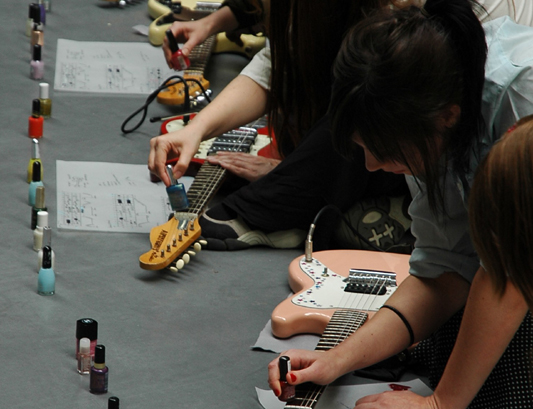By Luke Quinton
Published: Feb. 29, 2012

SPECIAL TO THE AMERICAN-STATESMAN
Of all the bizarre actions we associate with the late composer John Cage the man who made music from burning pinecones and moving water inside conch shells, who turned radio stations into instruments and composed a piece out of silence the thing we forget is that you have to count it out.
"There is that sense of a toy shop or a menagerie," says Adam Sliwinski from So Percussion, the acclaimed Brooklyn group that is about to play two different concerts next week at the University of Texas' McCullough Theatre to honor Cage's centennial.
As percussionists, Sliwinski says, "We don't have 400 years of history. We have 100 years of history."
Cage basically wrote the future of percussion music. "It's like foundation repertoire for what we do."
The percussion "lab" at UT is — as you'd expect — a very loud room. About a dozen players front a comical variety of noisemakers ("manning," because there's just one woman in the group). Gongs, marimba, bass drums, wood blocks, sirens and a piano are waiting for the baton of Thomas Burritt, UT's director of percussion studies.
The members of So Percussion are up front, watching as the students run through a piece from the 1930s by Edgard Varese. The ensemble is in residence, and playing its March dates thanks to the recent grant to UT from the Andrew W. Mellon Foundation. The grant is meant to help launch classical music into the new century, and appropriately, Varese's piece was written to anticipate the coming atomic age.
Sliwinski explains to the class what Varese was about, what's happening behind the beat. Varese, he says, "wanted to make electronic music." At the time, that was just out of reach, so he tried to make a new language of sounds, something entirely alien.
If you think "War of the Worlds," Duchamp, Robert Rauschenberg, you start to size up the creative landscape Cage was working in.
This era exploded with experimental art, and Cage, who greatly admired Varese, dedicated himself to discovering its musical possibilities. To make new sounds, he simply made new instruments.
Cage's materials are always unpredictable: crumpling paper, turntable needles, a hollowed-out tree. Anything, Cage discovered, could become music.
"It wasn't institutionally accepted like it is now," says Sliwinski. A lot of Cage's work was performed far outside the academy — at happenings and art museums.
So Percussion is at the forefront of a wave that Cage began. Champions of new music, including collaborations with pop electronica guru Dan Deacon, Sliwinski says they're taking it in their own direction.
In 1999, the idea of four graduate students emerging from school to found a percussion ensemble seemed unlikely at best.
But it didn't take long for them to gain traction, with concerts, commissions and university residencies very early on, including one at UT in 2002. It was a sign that they could make a living out of being percussionists.
"We came to UT and gave a completely insane concert of all the hardest music we knew how to play," Sliwinski says, smiling.
In those early days they got some of the highest profile commissions imaginable, from Pulitzer Prize winners David Lang of Bang on a Can and Steve Reich.
Now So Percussion is more than a decade in and established as teachers and a touring ensemble.
For their UT concerts, part of a limited spring tour that includes Toronto and Carnegie Hall, So Percussion is playing their favorite Cage music, and the music of his descendants.
At times, says Sliwinski, it's still an effort to explain how important Cage really was (and still is). "It shocks me how contemporary he feels."
Their ambassadorship continues. Online, they have a video of Cage's "Third Construction," a fiendishly complex piece with rotating rhythms that they'll play next week. Somehow they make it look easy, even memorizing their parts. The next video tells us exactly how they became so proficient: They sing it.
"The singing has helped us," Sliwinski says. They can practice without ever unpacking their instruments. Another reminder that percussionists have to be dedicated and brilliant technicians, with impeccable timing in order to pull it off.
After all, those pinecones won't burn themselves.
"We Are All Going In Different Directions: A John Cage Celebration" with So Percussion
When: 8 p.m. Tuesday and Wednesday
Where:McCullough Theatre, UT campus, 2375 Robert Dedman Drive.
Cost:$30
Information: www.texas?performingarts.org



